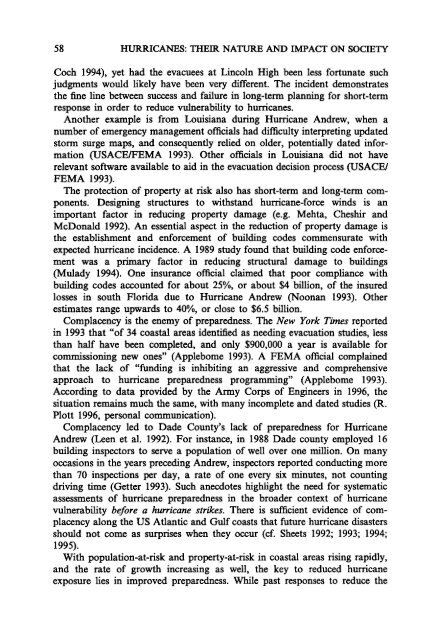Hurricanes: Their Nature and Impacts on Society - Climate Science ...
Hurricanes: Their Nature and Impacts on Society - Climate Science ...
Hurricanes: Their Nature and Impacts on Society - Climate Science ...
You also want an ePaper? Increase the reach of your titles
YUMPU automatically turns print PDFs into web optimized ePapers that Google loves.
58 HURRICANES: THEIR NATURE AND IMPACT ON SOCIETY<br />
Coch 1994), yet had the evacuees at Lincoln High been less fortunate such<br />
judgments would likely have been very different. The incident dem<strong>on</strong>strates<br />
the fine line between success <str<strong>on</strong>g>and</str<strong>on</strong>g> failure in l<strong>on</strong>g-term planning for short-term<br />
resp<strong>on</strong>se in order to reduce vulnerability to hurricanes.<br />
Another example is from Louisiana during Hurricane Andrew, when a<br />
number of emergency management officials had difficulty interpreting updated<br />
storm surge maps, <str<strong>on</strong>g>and</str<strong>on</strong>g> c<strong>on</strong>sequently relied <strong>on</strong> older, potentially dated informati<strong>on</strong><br />
(USACE/FEMA 1993). Other officials in Louisiana did not have<br />
relevant software available to aid in the evacuati<strong>on</strong> decisi<strong>on</strong> process (USACE/<br />
FEMA 1993).<br />
The protecti<strong>on</strong> of property at risk also has short-term <str<strong>on</strong>g>and</str<strong>on</strong>g> l<strong>on</strong>g-term comp<strong>on</strong>ents.<br />
Designing structures to withst<str<strong>on</strong>g>and</str<strong>on</strong>g> hurricane-force winds is an<br />
important factor in reducing property damage (e.g. Mehta, Cheshir <str<strong>on</strong>g>and</str<strong>on</strong>g><br />
McD<strong>on</strong>ald 1992). An essential aspect in the reducti<strong>on</strong> of property damage is<br />
the establishment <str<strong>on</strong>g>and</str<strong>on</strong>g> enforcement of building codes commensurate with<br />
expected hurricane incidence. A 1989 study found that building code enforcement<br />
was a primary factor in reducing structural damage to buildings<br />
(Mulady 1994). One insurance official claimed that poor compliance with<br />
building codes accounted for about 25%, or about $4 billi<strong>on</strong>, of the insured<br />
losses in south Florida due to Hurricane Andrew (No<strong>on</strong>an 1993). Other<br />
estimates range upwards to 40%, or close to $6.5 billi<strong>on</strong>.<br />
Complacency is the enemy of preparedness. The New York Times reported<br />
in 1993 that "of 34 coastal areas identified as needing evacuati<strong>on</strong> studies, less<br />
than half have been completed, <str<strong>on</strong>g>and</str<strong>on</strong>g> <strong>on</strong>ly $900,000 a year is available for<br />
commissi<strong>on</strong>ing new <strong>on</strong>es" (Applebome 1993). A FEMA official complained<br />
that the lack of "funding is inhibiting an aggressive <str<strong>on</strong>g>and</str<strong>on</strong>g> comprehensive<br />
approach to hurricane preparedness programming" (Applebome 1993).<br />
According to data provided by the Army Corps of Engineers in 1996, the<br />
situati<strong>on</strong> remains much the same, with many incomplete <str<strong>on</strong>g>and</str<strong>on</strong>g> dated studies (R.<br />
Plott 1996, pers<strong>on</strong>al communicati<strong>on</strong>).<br />
Complacency led to Dade County's lack of preparedness for Hurricane<br />
Andrew (Leen et al. 1992). For instance, in 1988 Dade county employed 16<br />
building inspectors to serve a populati<strong>on</strong> of well over <strong>on</strong>e milli<strong>on</strong>. On many<br />
occasi<strong>on</strong>s in the years preceding Andrew, inspectors reported c<strong>on</strong>ducting more<br />
than 70 inspecti<strong>on</strong>s per day, a rate of <strong>on</strong>e every six minutes, not counting<br />
driving time (Getter 1993). Such anecdotes highlight the need for systematic<br />
assessments of hurricane preparedness in the broader c<strong>on</strong>text of hurricane<br />
vulnerability before a hurricane strikes. There is sufficient evidence of complacency<br />
al<strong>on</strong>g the US Atlantic <str<strong>on</strong>g>and</str<strong>on</strong>g> Gulf coasts that future hurricane disasters<br />
should not come as surprises when they occur (cf. Sheets 1992; 1993; 1994;<br />
1995).<br />
With populati<strong>on</strong>-at-risk <str<strong>on</strong>g>and</str<strong>on</strong>g> property-at-risk in coastal areas rising rapidly,<br />
<str<strong>on</strong>g>and</str<strong>on</strong>g> the rate of growth increasing as well, the key to reduced hurricane<br />
exposure lies in improved preparedness. While past resp<strong>on</strong>ses to reduce the














